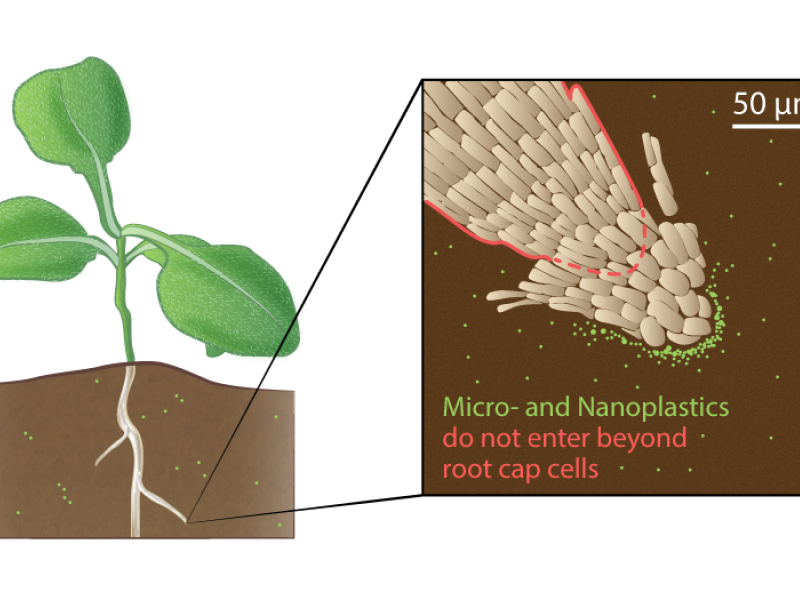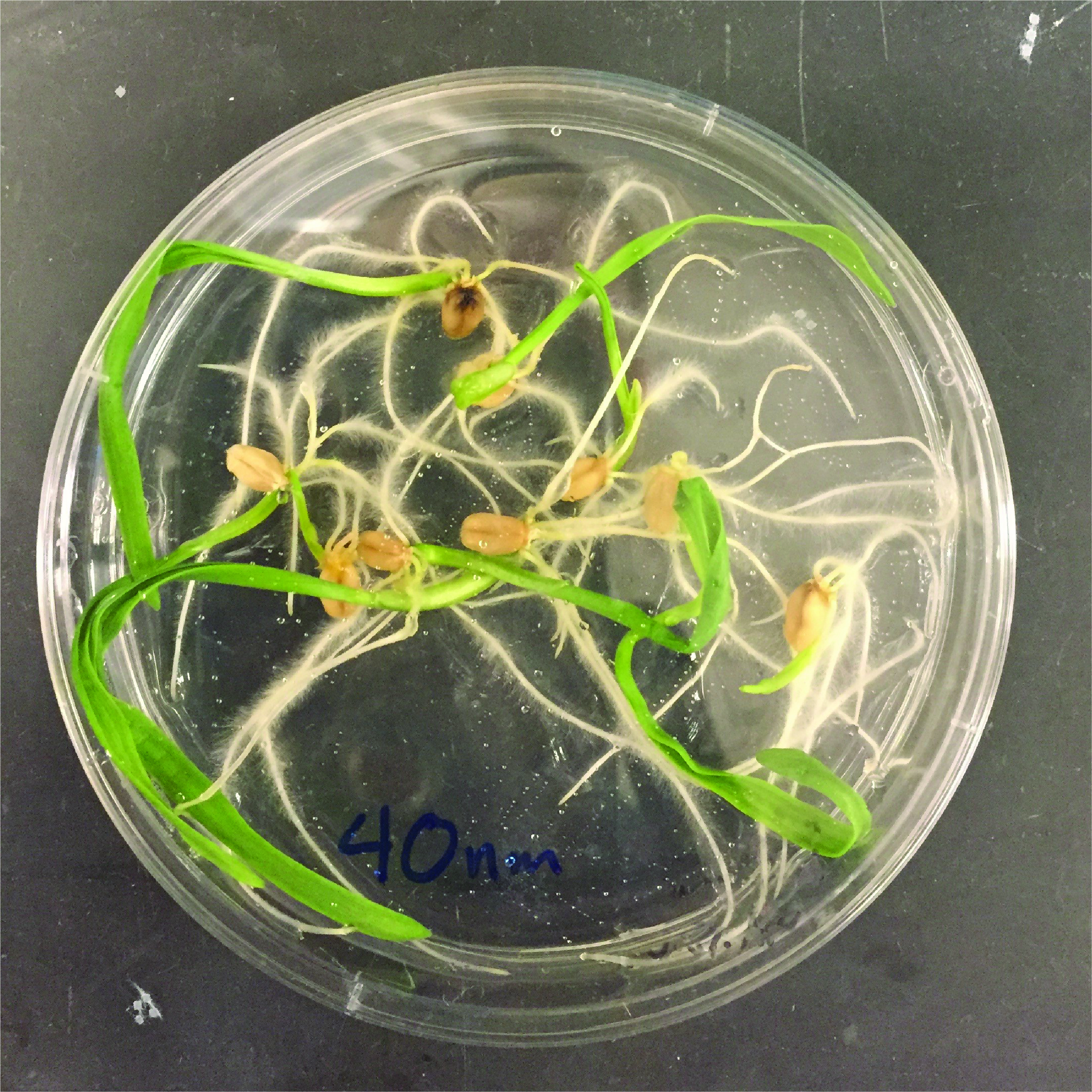Over the last decade, scientists have been scrambling to understand the impacts of microplastics. With the breakdown of plastic bottles, washing the world's seven billion fleece jackets, or the microbeads in face cleansers, microplastics are piling up. How they affect living things like plants is still unclear.
In soil, plastics have the potential to cause problems at the chemical level. Like a magnetic attraction, contaminants can bind to plastics, resulting in toxic accumulation. Contaminants can also hitch a free ride on plastics and potentially make their way into plants. But first, researchers need to know if microplastics-or their even smaller offspring called nanoplastics-can get into plant cells in the first place.
Here's some good news: they don't, according to a recent study from Pacific Northwest National Laboratory (PNNL) and Washington State University (WSU). However, microplastics do accumulate on the tips of roots, which could bode well for future cleanup of contaminated environments, but not well for root crops, like carrots.

Trojan horse for microplastics in plants
Microplastics are a global issue. Particles have been found in all corners of the Earth-from remote mountain tops to the ocean depths. Over the past decade, the bulk of microplastics research has skewed toward aquatic environments, which is ironic because more microplastics have been found on land.
"To understand issues with nano- and microplastics in plants, we have to really understand what's happening at the chemical and cellular level," said study co-author Carolyn Pearce, a geochemist at PNNL with a joint appointment in WSU's Department of Crop and Soil Sciences.
Like a toxic Trojan horse, microplastics can act as hot pockets of contaminant transport. They bind with and accumulate soil contaminants, such as long-lived polychlorinated biphenyls (PCBs). PCBs have been linked to cancer-production was banned in 1970, but they still linger in the environment. The result? A potential free ride into organisms and, perhaps, up the food chain.
The first step to testing the toxic Trojan horse theory is to see if microplastics can even enter plant cells in the first place. "We looked at where they might accumulate on plants, what materials attach, and how they concentrate," said Pearce.
Size matters when it comes to microplastics in plants
Not all microplastics are created equally. They can be as large as a pencil eraser or as small as a bacteria. Nanoplastics are tiny and are 100 times smaller than a plant cell. At that size, it's easy to imagine how plants could absorb plastic particles, but there are size limits regarding what passes through cell walls.
Generally, healthy adult plants only absorb materials 3-4 nanometers in size, which is even smaller than a virus. Some studies have shown that plants can absorb nanoparticles that are 10-12 times larger than that, up to 40-50 nanometers. While small particles pass through, the big question is-do plastics?

Sowing seeds (and a few microplastic beads)
To test the question, researchers zeroed in on two types of plants: Arabidopsis and soft white wheat. Arabidopsis is like the lab rat of the plant biology world. It's a commonly studied weed related to mustard, with a short life cycle. Soft white wheat is grown throughout the Pacific Northwest and is used in Asian noodles and crackers.
The researchers planted seeds on petri dishes containing agar mixed with two different sizes of micro- and nanoplastic beads. One size was virus-sized, while the other was 25 times larger. After allowing the seeds to grow for 5-12 days, researchers used a specialized microscope to take cross-sectioned images of the plant roots, allowing them to see root cells from all angles.
"We used a confocal microscope at EMSL, the Environmental Molecular Sciences Laboratory, which has been used to look at animal tissues, such as lung tissue. I thought it could be used for plants," said Stephen Taylor, a PNNL postdoctoral soil researcher and the study's lead author. He conducted the research while earning his PhD through the WSU-PNNL Distinguished Graduate Research Program. "As far as we know, it's the first time this technique has been used to look for plastics in plant cells."
Some good news amid 2020
No microplastic beads of either size were absorbed by any living tissue cells in either plant species.
"We saw plastic accumulation around the root cap cells, and some along the surface up the root. But, we didn't see any evidence of microplastic beads inside the cell structures, or in between the cells," said Taylor. The cap cells protect the sensitive, growing parts of roots, are short-lived, and are shed often. Bottom line-absorption isn't an issue, but attachment to the roots might be. This could potentially be an issue for root crops such as carrots, potatoes, or beets.
Beyond helping researchers learn more about whether plants absorb plastic particles, the results have potential environmental applications too.
"Microplastics are a problem that isn't going away," said Pearce. Imagining further research, she asked: "If we show that the plastics accumulate on the root tip, maybe we could use plants to remove plastics in other ecosystems?"
The findings may also have applications for creating more environmentally friendly plastics. "We could also use this information to manufacture plastics that can't get absorbed by plants and animals," she said.
There are benefits to knowing what microplastics do, or do not, get absorbed by living things.
"Ultimately, this will help scientists better understand the tipping point of where there is an impact to plants and ecosystems," said Pearce.
Microplastic uptake in plants was the focus of the following study: Taylor, S., Pearce, C., Sanguinet, K., Hu, D., Chrisler, W., Kim, Y., Wang, Z., and Flury, M. 2020. Polystyrene nano- and microplastic accumulation at Arabidopsis and wheat root cap cells, but no evidence for uptake into roots, which was published in Environmental Science: Nano and was classified as a HOT article because it received particularly high scores in the scientific peer-review process.
Funding for this study was provided by the WSU-PNNL Distinguished Graduate Student Fellowship and the United States Department of Agriculture's National Institutes of Food and Agriculture. Initial funds were provided by PNNL's Energy and Environment Directorate's Laboratory Directed Research and Development seed program. The Environmental Molecular Sciences Laboratory is a DOE Office of Science user facility.
Research Team: Carolyn Pearce (PNNL/WSU); Stephen Taylor, Dehong Hu, William Chrisler, and Yong-Mo Kim (PNNL); Karen Sanguinet and Markus Flury (WSU); and Zhang Wang (Shenyang Agricultural University, China).






